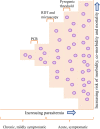Malaria therapeutics: are we close enough?
- PMID: 37060004
- PMCID: PMC10103679
- DOI: 10.1186/s13071-023-05755-8
Malaria therapeutics: are we close enough?
Abstract
Malaria is a vector-borne parasitic disease caused by the apicomplexan protozoan parasite Plasmodium. Malaria is a significant health problem and the leading cause of socioeconomic losses in developing countries. WHO approved several antimalarials in the last 2 decades, but the growing resistance against the available drugs has worsened the scenario. Drug resistance and diversity among Plasmodium strains hinder the path of eradicating malaria leading to the use of new technologies and strategies to develop effective vaccines and drugs. A timely and accurate diagnosis is crucial for any disease, including malaria. The available diagnostic methods for malaria include microscopy, RDT, PCR, and non-invasive diagnosis. Recently, there have been several developments in detecting malaria, with improvements leading to achieving an accurate, quick, cost-effective, and non-invasive diagnostic tool for malaria. Several vaccine candidates with new methods and antigens are under investigation and moving forward to be considered for clinical trials. This article concisely reviews basic malaria biology, the parasite's life cycle, approved drugs, vaccine candidates, and available diagnostic approaches. It emphasizes new avenues of therapeutics for malaria.
Keywords: Diagnostics; Malaria therapeutics; Plasmodium species; RTS,S; Rapid diagnostic test; Vaccine.
© 2023. The Author(s).
Conflict of interest statement
The authors have no conflicts of interest to declare.
Figures








Similar articles
-
Vaccines against malaria-still a long way to go.FEBS J. 2017 Aug;284(16):2560-2568. doi: 10.1111/febs.14107. Epub 2017 Jun 2. FEBS J. 2017. PMID: 28500775 Review.
-
Vaccines against malaria.Clin Infect Dis. 2015 Mar 15;60(6):930-6. doi: 10.1093/cid/ciu954. Epub 2014 Dec 1. Clin Infect Dis. 2015. PMID: 25452593 Free PMC article. Review.
-
Proteomic approaches to studying drug targets and resistance in Plasmodium.Curr Drug Targets Infect Disord. 2004 Mar;4(1):41-51. doi: 10.2174/1568005043480989. Curr Drug Targets Infect Disord. 2004. PMID: 15032633 Review.
-
UK malaria treatment guidelines.J Infect. 2007 Feb;54(2):111-21. doi: 10.1016/j.jinf.2006.12.003. Epub 2007 Jan 9. J Infect. 2007. PMID: 17215045
-
The role of different components of the immune system against Plasmodium falciparum malaria: Possible contribution towards malaria vaccine development.Mol Biochem Parasitol. 2021 Nov;246:111425. doi: 10.1016/j.molbiopara.2021.111425. Epub 2021 Oct 16. Mol Biochem Parasitol. 2021. PMID: 34666102 Free PMC article. Review.
Cited by
-
Allosteric modulation of Plasmodium falciparum Isoleucyl tRNA synthetase by South African natural compounds.PLoS One. 2025 May 14;20(5):e0321444. doi: 10.1371/journal.pone.0321444. eCollection 2025. PLoS One. 2025. PMID: 40367238 Free PMC article.
-
Computational design, expression, and characterization of a Plasmodium falciparum multi-epitope, multi-stage vaccine candidate (PfCTMAG).Heliyon. 2025 Jan 18;11(2):e42014. doi: 10.1016/j.heliyon.2025.e42014. eCollection 2025 Jan 30. Heliyon. 2025. PMID: 39906795 Free PMC article.
-
Exploring malaria parasite surface proteins to devise highly immunogenic multi-epitope subunit vaccine for Plasmodium falciparum.J Genet Eng Biotechnol. 2024 Jun;22(2):100377. doi: 10.1016/j.jgeb.2024.100377. Epub 2024 May 4. J Genet Eng Biotechnol. 2024. PMID: 38797552 Free PMC article.
-
Combating Malaria: Targeting the Ubiquitin-Proteasome System to Conquer Drug Resistance.Trop Med Infect Dis. 2025 Apr 3;10(4):94. doi: 10.3390/tropicalmed10040094. Trop Med Infect Dis. 2025. PMID: 40278767 Free PMC article. Review.
-
Therapeutic efficacy and safety of artemether-lumefantrine for uncomplicated Plasmodium falciparum malaria treatment in Metehara, Central-east Ethiopia.Malar J. 2024 Jun 12;23(1):184. doi: 10.1186/s12936-024-04991-2. Malar J. 2024. PMID: 38867217 Free PMC article.
References
-
- Roche B, Broutin H, Simard F. Optimizing public health strategies in low-income countries: the challenges to apply the scientific knowledge for disease control and for which diseases. Oxford: Oxford University Press; 2018.
Publication types
MeSH terms
Substances
Grants and funding
LinkOut - more resources
Full Text Sources
Medical

